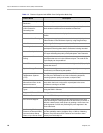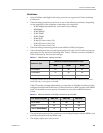
Polycom, Inc. 2-1
2
Conference Profiles
Profiles stored on the MCU enable you to define all types of conferences. Profiles include
conference parameters such as Conferencing Mode, Conference Session Type, Conference
Line Rate, People and Content resolution and settings, Video Layout, Encryption, Lost
Packet Recovery etc.
The maximum number of Conference Profiles that can be defined is:
• RealPresence Collaboration Server (RMX) 1500 - 40
• RealPresence Collaboration Server (RMX) 2000 - 40
• RealPresence Collaboration Server (RMX) 4000 - 80
Conference Profiles are assigned to Conferences, Meeting Rooms, Reservations and Entry
Queues. The same Profile can be assigned to different conferencing entities. When modifying
the Profile parameters, the changes will be applied to all the conferencing entities to which
the profile is assigned.
Conference Profile options differ according to the selected Conferencing Mode and Conference
Type. Profiles can be defined for AVC (Advanced Video Codec) conferencing Mode or SVC
(Scalable Video Codec) conferencing Mode. AVC Conferencing Mode, offers two Video
session types: Continuous Presence (CP) conferences and Video Switching (VSW)
Conferences. and a special functional conference - Operator Conferences.
Conference Profiles can be saved to Conference Templates along with all participant parameters,
including their Personal Layout and Video Forcing settings, enabling administrators and
operators to create, save, schedule and activate identical conferences. For more information
see Chapter 11, “Conference Templates” .
Conferencing Modes
The MCU system offers two Conferencing Modes:
• Transcoding - AVC Conferencing
• Media Relay - SVC Conferencing
Transcoding - AVC Conferencing
In this mode, video is received from all the endpoints using different line rates, different
protocols (SIP, H.323, PSTN and ISDN) and video parameters:
• Video protocols: H.261, H.263, H.264 Base and High profile and RTV
• Video Resolutions: from QCIF, CIF and up to 1080p
• Frame rates up to 60 fps
The MCU process the received video, transcodes it and send the resulting video streams to
the endpoints. The video processing that is required differs according to the video session
set for the conference, with all the processing performed by the MCU. For more details, see
"AVC Conferencing - Video Session Types” on page 2-2.


















